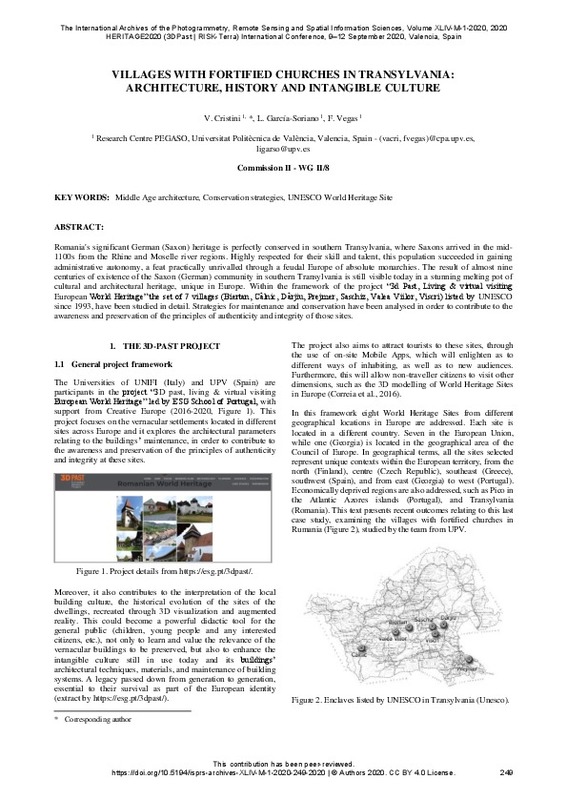JavaScript is disabled for your browser. Some features of this site may not work without it.
Buscar en RiuNet
Listar
Mi cuenta
Estadísticas
Ayuda RiuNet
Admin. UPV
Villages with Fortified Churches in Transylvania: Architecture, History and Intangible Culture
Mostrar el registro sencillo del ítem
Ficheros en el ítem
| dc.contributor.author | Cristini, Valentina
|
es_ES |
| dc.contributor.author | García-Soriano, Lidia
|
es_ES |
| dc.contributor.author | Vegas López-Manzanares, Fernando
|
es_ES |
| dc.date.accessioned | 2021-07-13T03:30:45Z | |
| dc.date.available | 2021-07-13T03:30:45Z | |
| dc.date.issued | 2020-07-24 | es_ES |
| dc.identifier.uri | http://hdl.handle.net/10251/169136 | |
| dc.description.abstract | [EN] Romania's significant German (Saxon) heritage is perfectly conserved in southern Transylvania, where Saxons arrived in the mid-1100s from the Rhine and Moselle river regions. Highly respected for their skill and talent, this population succeeded in gaining administrative autonomy, a feat practically unrivalled through a feudal Europe of absolute monarchies. The result of almost nine centuries of existence of the Saxon (German) community in southern Transylvania is still visible today in a stunning melting pot of cultural and architectural heritage, unique in Europe. Within the framework of the project ¿3d Past, Living & virtual visiting European World Heritage¿ the set of 7 villages (Biertan, Câlnic, Dârjiu, Prejmer, Saschiz, Valea Viilor, Viscri) listed by UNESCO since 1993, have been studied in detail. Strategies for maintenance and conservation have been analysed in order to contribute to the awareness and preservation of the principles of authenticity and integrity of those sites. | es_ES |
| dc.description.sponsorship | This paper is the result of the research project 3D Past - ¿Living & virtual visiting European World Heritage¿ [Grant Agreement Ref Nº570729-CREA-1-2016-1-PT-CULT-COOP1], which was co-funded by the European Union, under the programme Creative Europe (2016-2020). | es_ES |
| dc.language | Inglés | es_ES |
| dc.publisher | Copernicus Publ. | es_ES |
| dc.relation.ispartof | International Archives of the Photogrammetry, Remote Sensing and Spatial Information Sciences (Online) | es_ES |
| dc.rights | Reconocimiento (by) | es_ES |
| dc.subject | Middle Age architecture | es_ES |
| dc.subject | Conservation strategies | es_ES |
| dc.subject | UNESCO World Heritage Site | es_ES |
| dc.subject.classification | COMPOSICION ARQUITECTONICA | es_ES |
| dc.title | Villages with Fortified Churches in Transylvania: Architecture, History and Intangible Culture | es_ES |
| dc.type | Artículo | es_ES |
| dc.type | Comunicación en congreso | es_ES |
| dc.identifier.doi | 10.5194/isprs-archives-XLIV-M-1-2020-249-2020 | es_ES |
| dc.relation.projectID | info:eu-repo/grantAgreement/EC//2016-1740%2F001- 001/ | es_ES |
| dc.rights.accessRights | Abierto | es_ES |
| dc.contributor.affiliation | Universitat Politècnica de València. Departamento de Composición Arquitectónica - Departament de Composició Arquitectònica | es_ES |
| dc.description.bibliographicCitation | Cristini, V.; García-Soriano, L.; Vegas López-Manzanares, F. (2020). Villages with Fortified Churches in Transylvania: Architecture, History and Intangible Culture. International Archives of the Photogrammetry, Remote Sensing and Spatial Information Sciences (Online). 44:249-254. https://doi.org/10.5194/isprs-archives-XLIV-M-1-2020-249-2020 | es_ES |
| dc.description.accrualMethod | S | es_ES |
| dc.relation.conferencename | HERITAGE2020 (3DPast | RISK-Terra), International Conference on Vernacular Architecture in World Heritage Sites. Risks and New Technologies | es_ES |
| dc.relation.conferencedate | Septiembre 09-12,2020 | es_ES |
| dc.relation.conferenceplace | Valencia, España | es_ES |
| dc.relation.publisherversion | https://doi.org/10.5194/isprs-archives-XLIV-M-1-2020-249-2020 | es_ES |
| dc.description.upvformatpinicio | 249 | es_ES |
| dc.description.upvformatpfin | 254 | es_ES |
| dc.type.version | info:eu-repo/semantics/publishedVersion | es_ES |
| dc.description.volume | 44 | es_ES |
| dc.identifier.eissn | 2194-9034 | es_ES |
| dc.relation.pasarela | S\418026 | es_ES |
| dc.contributor.funder | European Commission | es_ES |








